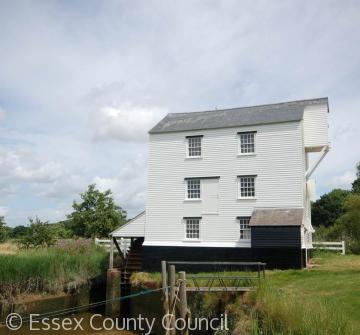Thorrington Tide Mill

Thorrington Tide Mill
Thorrington tide mill is located at the head of Alresford creek which branches east from the River Colne and forms the parish boundary between Brightlingsea, Alresford and Thorrington. Upstream of the mill pool or pond is Tenpenny Brook. It is not known when the mill was built, but by the 17th century a mill stood on a dam separating the saltwater creek from the mill pool. On an incoming tide a sluice would have been opened in the dam allowing the mill pool to fill. Then on the ebb tide the stored water would have been released by another sluice to drive the undershot water wheel. This mill probably always ground corn for flour to make bread. The power of the external waterwheel was harnessed via geared machinery to rotate pairs of millstones, with the lower stone fixed and the upper stone rotating. The corn was ground between them, the gap between the stones being adjustable. Each pair of millstones was housed in a wooden box called a ‘tun’, and the corn was fed into the centre hole or ‘eye’ of the millstones by gravity from above.
Although much of the flour produced by the mill may have been consumed locally, Thorrington mill had an adjacent lading place, where small ships such as barges could dock. This meant that corn could be brought to the tide mill for processing and the flour produced then exported to other places. A sale catalogue of 1810 records that alongside the necessary machinery Thorrington mill then had a new waterwheel, and “two pairs of excellent French stones”. These stones were ‘French Burrs’, a type of hard quartzite, quarried in the Paris basin and assembled from many small pieces to produce completely round millstones. The millstones had channels cut into them called furrows, the areas between being known as ‘lands’. As the stones wore out, so periodically they had to be repaired and their furrows redressed by skilled craftsmen called stone dressers.
Tide mills were dependent upon the fluctuating size and timing of tides so additional milling power was sometimes provided by the construction of an accompanying windmill, which used a different natural source of power – the wind. This was the case at Thorrington where a windmill was depicted on Chapman and Andre’s county map of Essex in 1777. It lasted until 1869 when it blew down. Mills were often worked by families for generations, the skills of the trade being passed from father to son. At Thorrington members of the Cooper family ran the tide mill from 1841 to 1912 and it continued working until 1926. It was later acquired by Tom Glover who maintained the building until he sold it to Essex County Council in 1974.
The present mill on the dam was built in 1831 and is a tall three-storeyed timber-framed building. It has a brick plinth but the rest is clad in white-painted weatherboarding so typical of Essex mill buildings. At the west end of the dam are the sluices and an external cast iron water wheel 16 ft in diameter, with wooden ‘floats’ for catching the water, and an iron shaft to transfer the power into the mill. The curious projecting structure with a doorway on the third-storey is known as the lucam. Corn was brought in sacks on a cart to directly under the lucam and then a sack hoist also powered by the waterwheel lifted the sacks into the top floor of the mill. From there the corn could be fed down into the milling machinery and millstones by gravity. Essex County Council still own and maintain the building which they have restored, and it is open to the public on certain days. It is one of the few tide mills in Great Britain that is still operational and therefore of national significance in explaining how the natural resource of the tides was harnessed to produce power in the past. “Green” energy is nothing new!
For location, website and opening times see: http://www.essex.gov.uk/Activities/Heritage/Pages/Mills-in-Essex.aspx
Sources: Geoff Wood, Thorrington Tide Mill (ECC, Heritage Conservation branch, guidebook, 2003); H. Benham, Some Essex Water Mills (2nd edition, 1983), pp. 104–05; J. Bettley and N. Pevsner, The Buildings of England. Essex (2007 edition), p. 781; inf. supplied by David Morgans and James Owden (ECC).



